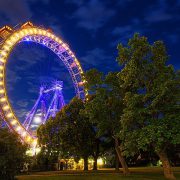Exactly 250 years ago Emperor Franz Joseph decided to open the Viennese Prater to the community making a 6 square kilometre big area open to public. Until this point of time the floodplain area around the Danube located within the borders of todays second district was dedicated to the nobility. Until 1766 the Prater was only open for hunting and an opening for everyone was not welcomed by everyone. Thanks to the ruling of Emperor Franz Joseph the use of the Prater changed substantially. Due to the 250 years anniversary we take a look on the history and present of the Prater and how it is used today.
Starting years

The beginning of the Prater
If one would compare the Prater 250 years ago with today it is nearly impossible to recognize it. 250 years ago the area was dominated by deep forests, wild animals and broad alleys. Even if the Prater was accepted by the locals from the beginning on the look of the area changed a lot over the years. 5 years after the opening to public the visitors could experience more than just green areas for their first time. More than 10,000 spectators visited the first firework show at the prater. Over the following 100 years fireworks were a crucial part of the Prater and inspired the Viennese audience until it was forbidden by law in 1871. More and more facilities were created within the Prater putting it into the centre of the social life of Vienna at these times. From 1783 the Lusthaus was build at the south eastern end of the main alley and quickly turned into a centre of Vienna’s high society. Even the Emperor visited the small building from time to time. Furthermore in the following years three café were developed. In these up to 5,000 persons holding cafés well known composers, amongst other Beethoven, the Strauß brothers or Johann Strauss Son, hosted concerts there. Unfortunately none of the three café survived until today. Two of them burned down during WWII and the third was torn off in 1962. Also with the opening of the Prater carnies moved from the old town to the Prater. While this part of the Prater was soon called “Wurstelprater” the name was changed to “Volksprater” during the time of Biedermeier and was kept by the government until today. However the name “Volksprater” was not accepted by the locals and is only used rarely.
World expo 1873

The Rotunde
For the world expo 1873 the Viennese Prater was extensively changed. The amusement park hat to be shut down and the area were used for the exhibition. Furthermore new buildings and exhibition areas were created. Among the most important planning measures were the constructions of the Vivarium, a show-aquarium, the pavilions, the only left over of the exhibition, and the Rotunde – the biggest domed structure at its time. While the Rotunde was used until a fire in 1937 most of the buildings were destroyed during the fight for Vienna in WWII. Today only the two pavilions close to the stadium remind of the world exhibition.
From 1874

Prater today
At the end of the 19th century the Vienna Giant Wheel, today Vienna’s landmark was built. Thanks to the settling of the Vienna Giant Wheel also other fairground rides were created around the Viennese Prater. Around 1900 the “Venice of Vienna” the first theme park worldwide was established. Thanks to many channels and showman booths the small version was redolent to its Italian original. Over the years more and more fun rides were established and in 1933 the first haunted house worldwide was also created at the Prater. Unfortunately nearly all fun rides were destroyed during WWII. After WWII the amusement park was recreated and it established in its present form. Today the amusement park offers more than 250 fun rides and attracts about 3 million visitors per year. Furthermore you can find Austria’s biggest stadium within the Prater and along the main alley many sport events are held every year. The Viennese Prater is no longer a pourable part of Vienna and even without the Vienna Giant Wheel it would be a sight for itself.




